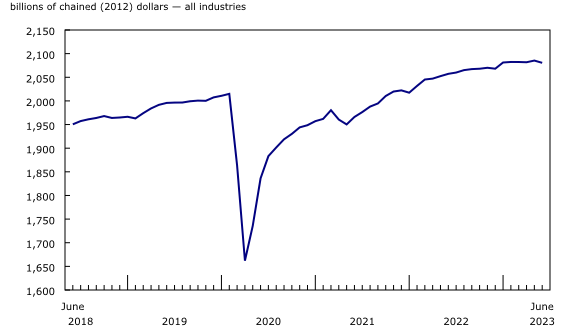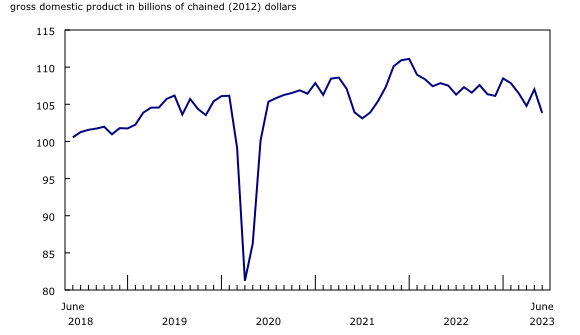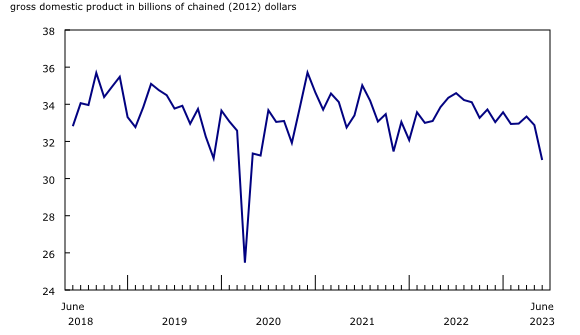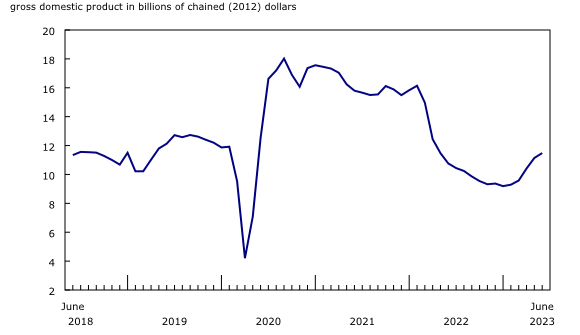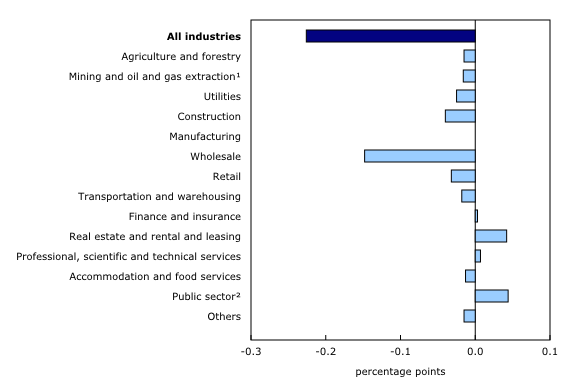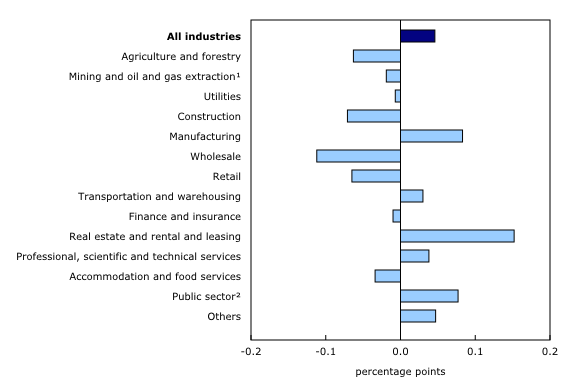Gross domestic product by industry, June 2023
Released: 2023-09-01
June 2023
-0.2% 
(monthly change)
Real gross domestic product (GDP) decreased 0.2% in June, following a 0.2% increase in May. Both services-producing industries (-0.2%) and goods-producing industries (-0.4%) contracted in June with 12 of 20 industrial sectors posting decreases.
Wholesale trade falls after strong May
After being one of the largest contributors to growth in May, wholesale trade (-3.0%) was the largest contributor to the decline in June as higher levels of activity observed across multiple subsectors in May were not sustained through June.
In total, seven of nine subsectors decreased in the month. Machinery, equipment and supplies wholesalers contributed the most to the decline with a 5.7% drop, its sharpest decrease since April 2020. This June 2023 decline more than offset the large gain recorded in May.
Miscellaneous wholesalers fell 7.0% in June, while motor vehicle and motor vehicle parts and accessories wholesalers contracted 2.8%.
Forest fires adversely impact multiple industries
Fires in northern Quebec led to multiple mine closures in the region in June. The mining, quarrying and oil and gas extraction sector decreased for a second month in a row, down 0.3% in June.
Mining and quarrying (except oil and gas) fell 5.7% in June, its largest monthly contraction since November 2021, as all subsectors were down in the month. Metal ore mining decreased 6.7% in June 2023, primarily as a result of a 35.0% drop in the iron ore mining industry as a combination of wildfires and maintenance severely impacted production in northern Quebec and in Newfoundland and Labrador. In contrast, increases in copper, nickel, lead and zinc ore mining and gold and silver ore mining partially offset the drop. Meanwhile, non-metallic mineral mining decreased 4.5%, largely due to a 9.7% fall in potash mining.
In addition to affecting the mining and quarrying (except oil and gas) subsector in June, wildfires also negatively impacted the rail transportation subsector (-6.6%), which saw its fourth decline in five months. A temporary suspension of a rail line that supports an iron ore mine in the Labrador West area severely impacted iron ore railway carloadings, which fell considerably. Potash carloadings, which fell for the third month in a row, further contributed to the decline in the subsector.
Accommodation and food services contracted 0.6% in June, as both subsectors posted declines. Activity in recreational vehicle (RV) parks and recreational camps and rooming and boarding houses posted a second consecutive drop as the impacts of forest fires continued to restrict or limit activity at camping grounds. The food services and drinking places subsector edged down 0.2% in June after two consecutive monthly increases.
Energy sector rebounds in June
Oil and gas extraction rose 1.1% in June, partly offsetting a 3.4% contraction in May when the wildfires in Alberta impacted the subsector.
Oil and gas extraction (except oil sands) increased 2.9% as both crude petroleum and natural gas extraction rose in June. Oil sands extraction was essentially unchanged as higher crude bitumen extraction was offset by lower synthetic oil production.
Support activities for mining, and oil and gas extraction increased 3.2% as all types of supporting activities were up in June.
Pipeline transportation expanded for the fifth time in the last six months, rising 2.4% in June, as higher pipeline transportation of natural gas as well as crude oil and other products contributed to the growth.
Construction activity falls
Construction activity was down for the second consecutive month, decreasing 0.6% in June, as residential and non-residential construction activity contributed to the decline. Residential building construction (-2.0%) was the largest contributor to the decrease, down for the 14th time in 15 months, reflecting continued declines in home alterations and improvement, and lower construction of new single-detached homes in the month.
Non-residential building construction (-1.4%) posted a second consecutive decline, as construction of commercial, public and industrial buildings all fell for a second month in a row. Engineering and other construction activities partially offset these declines with a 0.5% increase, continuing the upward trend that began at the end of 2020.
Real estate and rental and leasing growth continues
Real estate and rental and leasing rose 0.3% in June, as two of three subsectors were up. The sector has been growing continuously since November 2022.
Activity at the offices of real estate agents and brokers and activities related to real estate (+3.0%) contributed the most to the increase in June, up for the fifth consecutive month. Demand for real estate remained strong as just over half of markets saw gains, with increases in British Columbia and Alberta offsetting lower activity in the Greater Toronto Area.
Public sector grows
The public sector (educational services, health care and social assistance and public administration) increased for the second consecutive month, up 0.2% in June. Public administration led the growth, continuing to rebound from the effect of a strike action by federal government workers in April and May.
Air transportation declines
Technical issues for air carriers at the beginning of June as well as nationwide staffing shortages at multiple airports adversely affected the air transportation subsector (-1.2%) in June. This was the first decline since January 2023 for the subsector, which is nearly 28% below the pre-COVID-19 pandemic level of activity.
Advance estimate for real gross domestic product for July 2023
Advance information indicates that real GDP was essentially unchanged in July. Increases in the public, finance and insurance, and professional, scientific and technical services sectors were offset by decreases in the manufacturing, transportation and warehousing, and construction sectors. Owing to its preliminary nature, these estimates will be updated on September 29, 2023, with the release of the official GDP data for July.
Real gross domestic product by industry flat after seven quarters of growth
Real GDP by industry was essentially unchanged in the second quarter of 2023, following growth of 0.6% in the first quarter, as growth in services-producing industries (+0.2%) was largely offset by a contraction in goods-producing industries (-0.3%).
Real estate and rental and leasing (+1.1%) was the largest contributor to growth in the second quarter, rising for the third consecutive quarter and at an accelerating pace for the last two quarters. Activity at the offices of real estate agents and brokers and activities related to real estate (+17.7%) was up for the first time in six quarters and drove the increase in the sector. Home resale activity increased in the majority of Canadian markets in all three months of the second quarter.
Meanwhile, the construction sector contracted 1.0% in the second quarter, mainly due to a continued contraction in the residential building construction subsector. This subsector (-6.2%) was down for a fifth consecutive quarter, reflecting declines in home alterations and improvement, and in construction of new single-detached homes. Only engineering and other construction activities (+3.2%) rose, up for an 11th consecutive quarter.
The manufacturing sector (+0.9%) rose for a second consecutive quarter, as both non-durable goods and durable goods manufacturing increased. Transportation equipment manufacturing led the growth in the sector, rising for a third consecutive quarter.
Wholesale trade (-2.2%) was the largest detractor to growth in the second quarter as all subsectors except petroleum and petroleum products wholesaling (+3.4%) and motor vehicle and motor vehicle parts and accessories wholesaling (+2.1%) were down.
Similarly, retail trade contracted 1.3% in the second quarter, down for the third time in the last four quarters, as 7 of 12 subsectors were down. Reduced activity at gasoline stations and at furniture and home furnishing stores contributed the most to the quarterly decline.
The public sector edged up 0.4% in the second quarter of 2023, increasing for the 12th consecutive quarter. This was the sector's smallest growth rate since the first quarter of 2022, as a strike by federal government workers represented by the Public Service Alliance of Canada labour union that began in April 2023 dampened growth.
Growing drought and forest fires impact several sectors
The agriculture, forestry, fishing and hunting sector fell 3.5% in the second quarter. This was the sector's second consecutive quarterly decline. Growing drought and wildfires in many regions of the country contributed to lower crop (except cannabis) production in the quarter (-4.2%) as the yield outlook for the year declined. Forestry and logging (-4.5%) and fishing, hunting and trapping (-9.8%) were also down in the quarter, while support activities for agriculture and forestry, which include forest firefighting activities, was up 1.8%.
Mining, quarrying, and oil and gas extraction (-0.3%) contracted as forest fires affected activity in natural gas and crude oil extraction in Alberta in May, and iron ore mining in Quebec and Newfoundland and Labrador in June. Accommodation services (-1.6%) posted its first quarterly decline in the last five quarters in the second quarter, as forest fires which began in late April in Canada, coupled with poor air quality associated with fires, restrained or indirectly discouraged activity in recreational vehicle (RV) parks and recreational camps.
Sustainable development goals
On January 1, 2016, the world officially began implementing the 2030 Agenda for Sustainable Development—the United Nations' transformative plan of action that addresses urgent global challenges over the following 15 years. The plan is based on 17 specific sustainable development goals.
The release on gross domestic product by industry is an example of how Statistics Canada supports monitoring the progress of global sustainable development goals. This release will be used to help measure the following goal:

Note to readers
Monthly data on gross domestic product (GDP) by industry at basic prices are chained volume estimates with 2012 as the reference year. This means that the data for each industry and each aggregate are obtained from a chained volume index multiplied by the industry's value added in 2012. The monthly data are benchmarked to annually chained Fisher volume indexes of GDP obtained from the constant-price supply and use tables (SUTs) up to the latest SUT year (2019).
For the period starting in January 2020, data are derived by chaining a fixed-weight Laspeyres volume index to the previous period. The fixed weights are 2019 industry prices.
This approach makes the monthly GDP by industry data more comparable with expenditure-based GDP data, which are chained quarterly.
All data in this release are seasonally adjusted. For information on seasonal adjustment, see Seasonally adjusted data – Frequently asked questions.
An advance estimate of industrial production for July is available upon request.
For more information on GDP, see the video "What is Gross Domestic Product (GDP)?."
Revisions
With this release of monthly GDP by industry, revisions have been made back to January 2022.
Each month, newly available administrative and survey data from various industries in the economy are integrated, resulting in statistical revisions. Updated and revised administrative data (including taxation statistics), new information provided by respondents to industry surveys, data confrontation and reconciliation process and standard changes to seasonal adjustment calculations are incorporated with each release.
Real-time table
Real-time table 36-10-0491-01 will be updated on September 11.
Next release
Data on GDP by industry for July will be released on September 29.
Products
The User Guide: Canadian System of Macroeconomic Accounts (13-606-G) is available.
The Methodological Guide: Canadian System of Macroeconomic Accounts (13-607-X) is also available.
The Economic accounts statistics portal, accessible from the Subjects module of the Statistics Canada website, features an up-to-date portrait of national and provincial economies and their structure.
Contact information
For more information, or to enquire about the concepts, methods or data quality of this release, contact us (toll-free 1-800-263-1136; 514-283-8300; infostats@statcan.gc.ca) or Media Relations (statcan.mediahotline-ligneinfomedias.statcan@statcan.gc.ca).
- Date modified:

